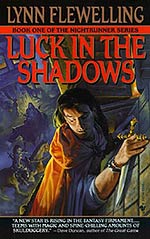
![]() Stella Atrium
Stella Atrium
2/7/2013
![]()
I love castle stories. What could be better than a 350-page fantasy novel that starts out with three companions on horseback with swords and Radly bows crossing a frigid field to escape the bad guy or to rescue the princess?
I celebrate that there's no end to these horse-and-castle stories, and I investigate whatever's new. Some novels like A Quest for Heroes by Morgan Rice are calibrated for a juvenile audience and the heroine is too young for insights I would seek. Some stories follow the new trend of heaps of gore and lists of knightly heraldry like The Wilding by CS Freidman. For some stories I don't buy the second book in the series because not enough surprises held my attention during the first outing, like Blood of the Falcon by Court Ellyn.
I picked up Luck in the Shadows because I had enjoyed all three Bone Doll's Twin stories, and especially the gender-bending twist. The witch who lived in the forest and the young magician who she trained were diverting enough for use of magic. Though the three stories lagged in places, a whimsical holy man arrived like a breath of fresh air to resolve some plot difficulties. A 15-year-old girl in full armor and long sword at the head of an army to save the empire was a bit of a stretch, but at least she was a girl, and she had female relatives who had roles in the plot (more than decorative).
But… I would call Flewelling's Luck in the Shadows a lighter version of The Golden Fool by Robin Hobb. Over the past two decades, Hobb wrote four series (series-es) around the enduring friendship between a fool with a mysterious background and an apprentice to a wizard. There are same-sex undertones, but each becomes the beloved to the other through their many adventures.
Flewelling's Book I of her Nightrunner series presents a watcher with a longer life than many, a wizard who commands spells for shape-shifting and message bubbles, and an orphan (why is it always an orphan?) who is a quick learner (why is he always more gifted at picking up dark skills?). Without a girl/boy love story to carry the reader through the MANY discussions of the heroics of former queens, and more discussions of the dead wizards who helped the dead queens, getting to the end was a struggle.
I don't care about those old queens. I have no context for those old queens.
Flewelling presents a bad guy (why do they always have no redeeming value?) who pursues our watcher and apprentice, but she drops this story line in the middle of the book in favor of describing the needed lessons in swordplay for the apprentice (why are long descriptions of training with swords required for fantasy writers?)
The struggle in the final act means the watcher and apprentice fight on the side of the current royal family for whom only three scenes were spared, and vanquish a long-simmering blood feud for which only two scenes were constructed.
Again, the reader doesn't feel invested in solving the problem at hand, especially since the resolution was a matter of home invasion and a fire contained in a single room. A comparison to Hobb's white queen in Fool's Fate comes to mind, wherein the queen lost her captain, her familiar, her ice castle, and her hands before her suffering ended.
The bad guys in Flewelling's story had not shown their faces again by the end of Book I, but the homoerotic undertones were coming to light. If there were more surprises, fewer long-winded stories about dead queens, less description, more jeopardy, more hetero romance – then I could overlook the disjointed plot. I doubt that I pick up Book II.
http://stellaatrium.com/luck-in-the-shadows